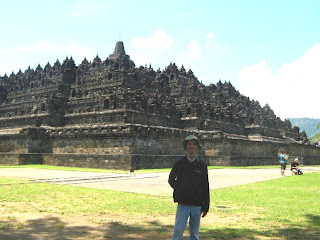
The Prambanan temple is the biggest and a most beautiful Hindu temple about 20 minutes from Yogyakarta city. This magnificent Shivaite temple derives its name from the village where it is located. Locally known as the Loro Jongrang temple, or the temple of the "Slender Virgin" it is reputed to be the biggest and most beautiful Hindu Temple in Indonesia.17 kilometers east of Yogyakarta, the temple is believed to have been built by King Balitung Maha Sambu in the middle of the ninth century.
Its parapets are adorned with a bas-reliefs depicting the famous Ramayana story. It has eight shrines, of which the three main ones are dedicated to Shiva, Vishnu and Brahma (all are manifestations of God in Hindu). The main temple of Shiva rises to a high of 130 feet and houses the magnificent statue of Shiva's consort, Durga.

Prambanan Temple is beautiful temple, in fact, it is a group of temples. The biggest temple dedicated to Shiva (one of manifestation of God) with two other smaller ones, on its right and on its left, dedicated to Brahma and Wisnhu (manifestation of God) respectively. Reliefs decorating the walls of the temple depict the story of Ramayana.

 This wonderful park stands at an elevation between 800 to 1500 meters above sea level, with temperature ranging between 20 to 25 degrees Celsius. Taman Safari Indonesia II was designed with two concepts in mind combining modern zoo tourism with an area of natural beauty. It was opened for the public on December 29, 1997 by Governor of East Java Bpk. Basofi Sudirman. At that time it held about 900 animals from 125 different species. Now the collection has more than 2500 animals from 200 different species.
This wonderful park stands at an elevation between 800 to 1500 meters above sea level, with temperature ranging between 20 to 25 degrees Celsius. Taman Safari Indonesia II was designed with two concepts in mind combining modern zoo tourism with an area of natural beauty. It was opened for the public on December 29, 1997 by Governor of East Java Bpk. Basofi Sudirman. At that time it held about 900 animals from 125 different species. Now the collection has more than 2500 animals from 200 different species.  More than of these were born in the park Taman Safari Indonesia II is generally divided into four zones which are Animals Park, Recreation Area, Baby Zoo and Water World which features adventure swimming with crocodiles. . Taman Safari Indonesia presents an unforgettable safari adventure for the entire family.
More than of these were born in the park Taman Safari Indonesia II is generally divided into four zones which are Animals Park, Recreation Area, Baby Zoo and Water World which features adventure swimming with crocodiles. . Taman Safari Indonesia presents an unforgettable safari adventure for the entire family. 





